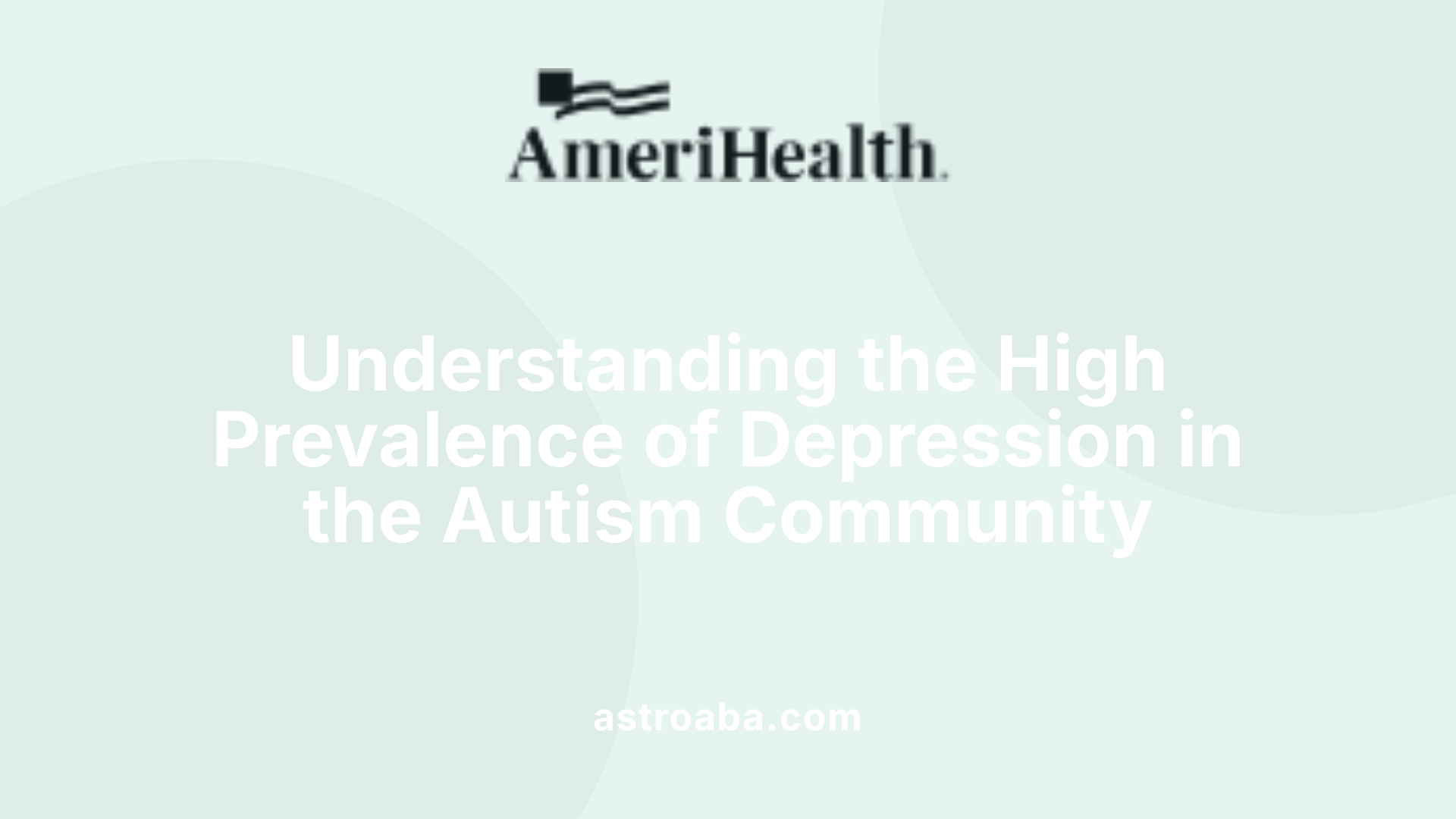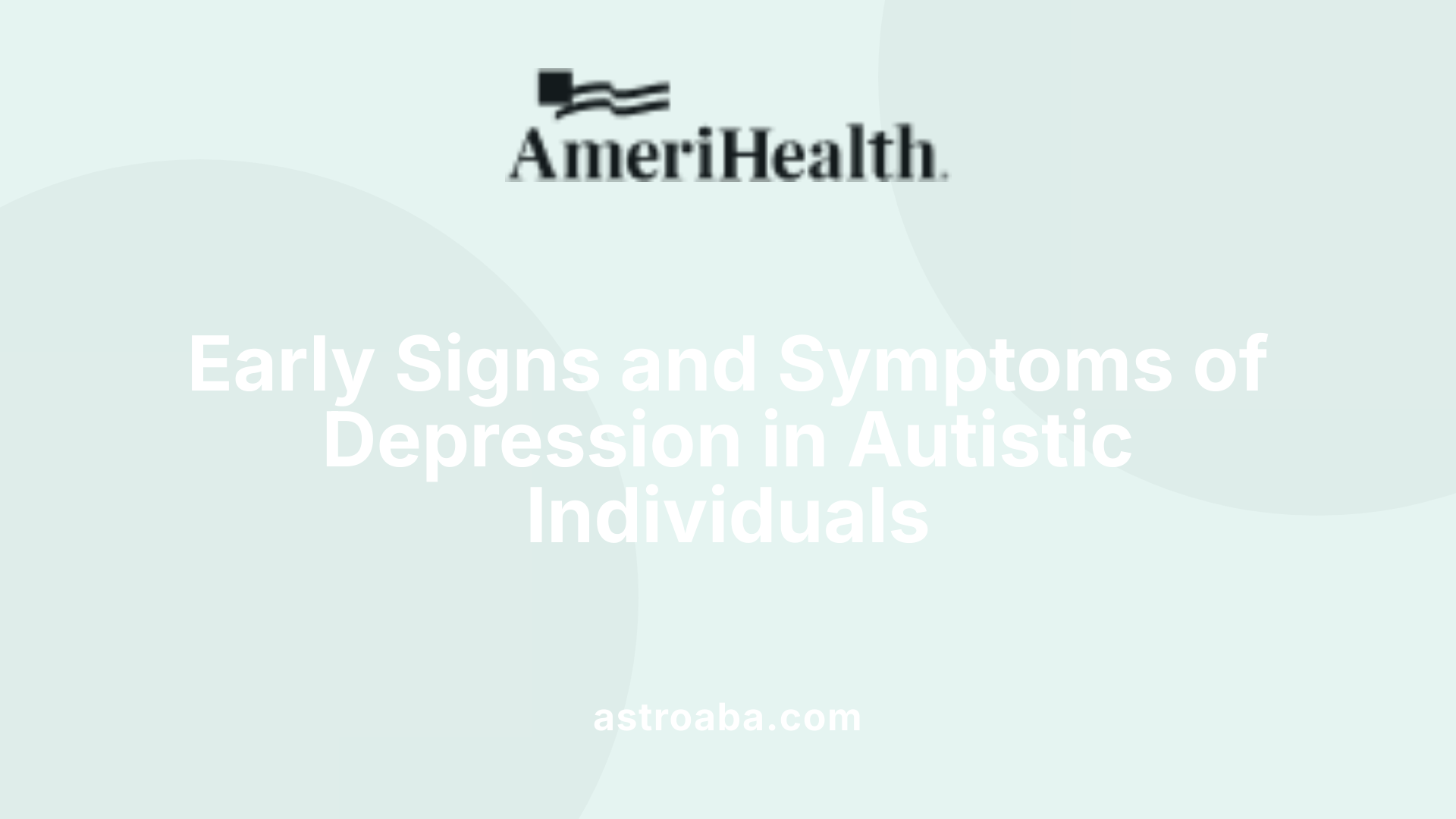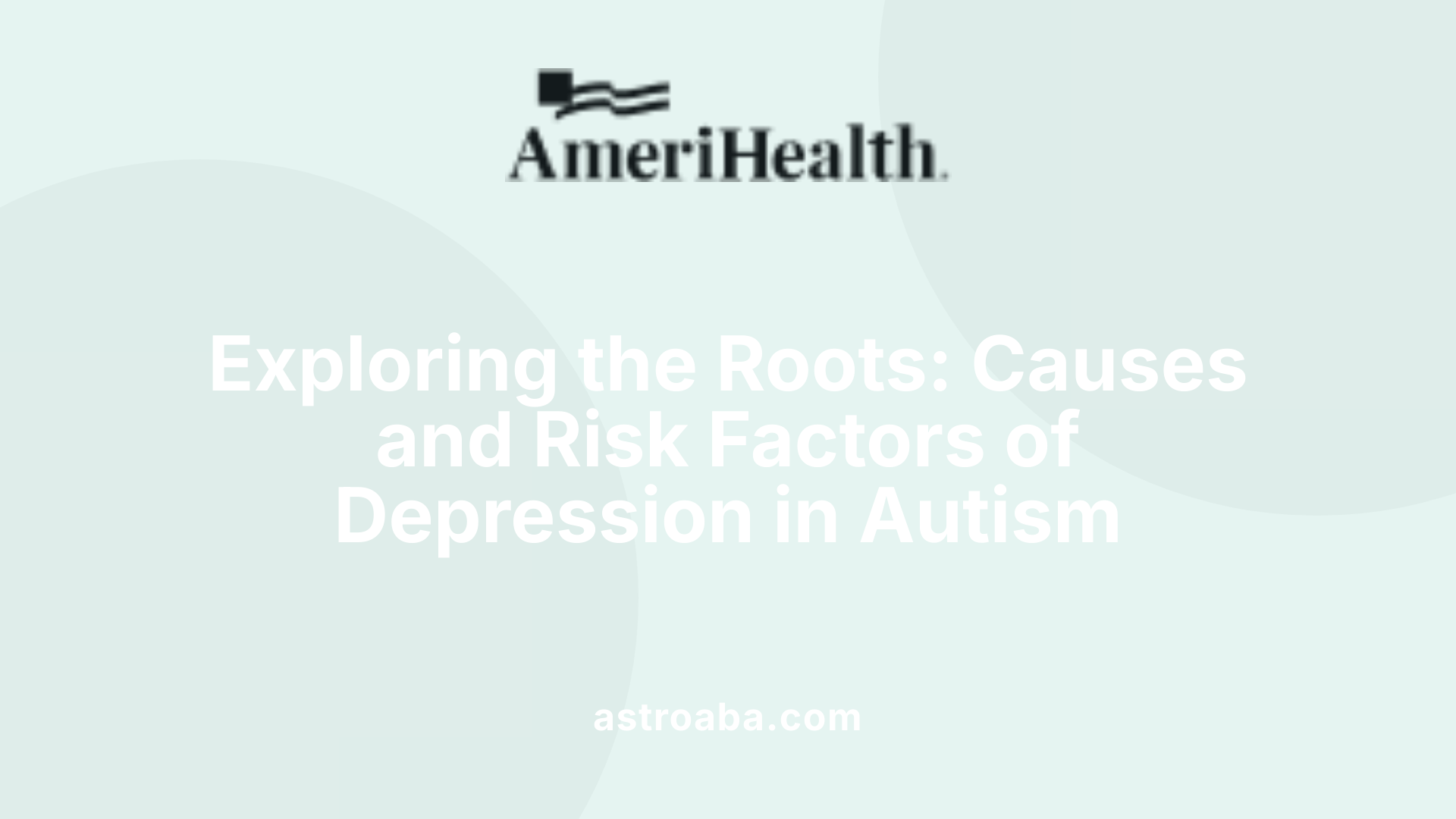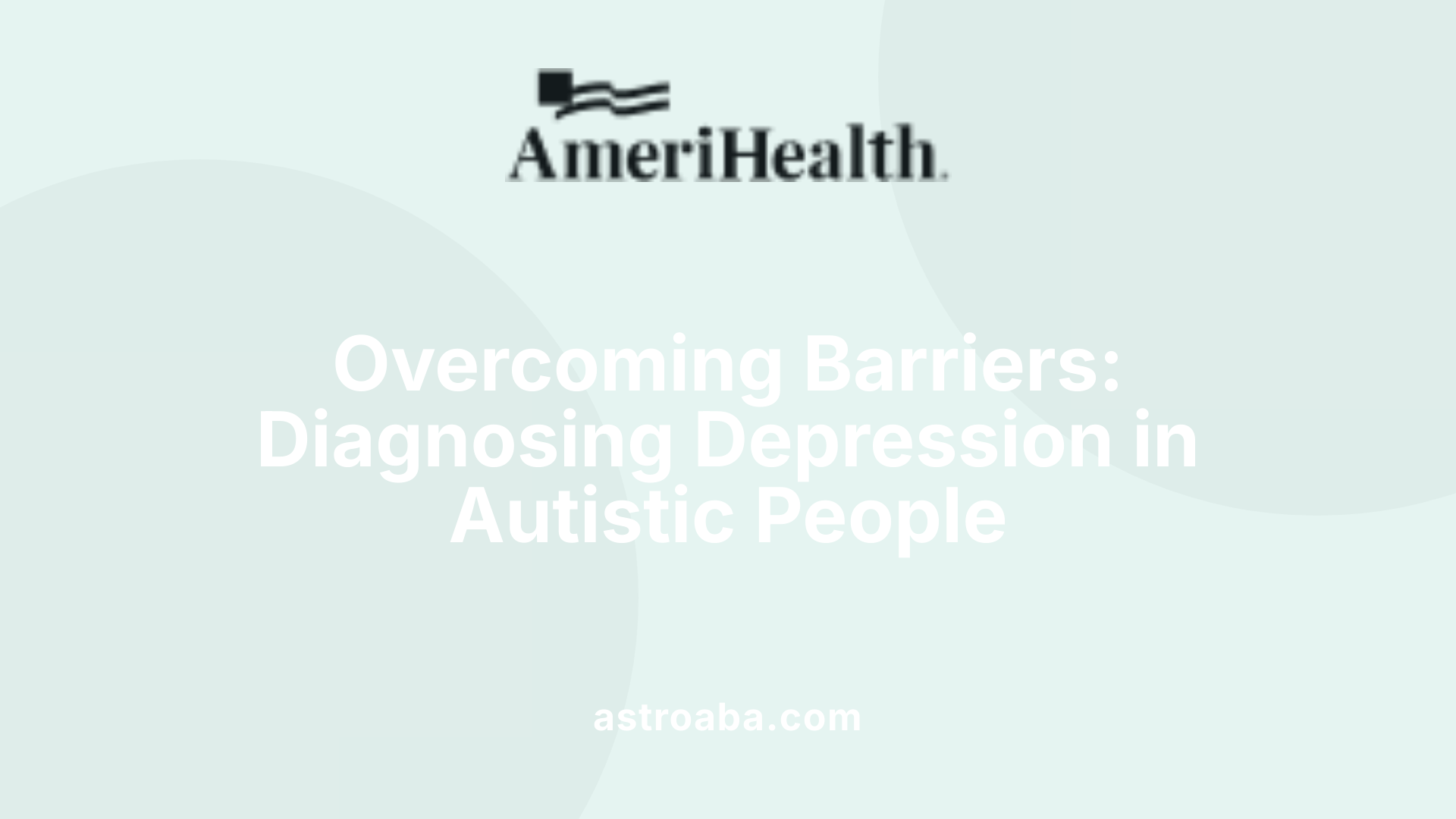Autism and Depression
Understanding the Link Between Autism and Depression: Challenges and Opportunities

Exploring the Complex Relationship Between Autism and Mental Health
Autism spectrum disorder (ASD) is a neurodevelopmental condition characterized by social, communication, and behavioral differences. While much focus has been placed on understanding ASD itself, research increasingly highlights the significant link between autism and mental health challenges, particularly depression. Autistic individuals are at a notably higher risk of experiencing depression compared to the general population, with estimates suggesting that up to 40% of autistic adults and between 8% and 26% of children and adolescents may face depressive episodes during their lifetime. This elevated prevalence necessitates a nuanced understanding of how depression manifests in autistic individuals, the challenges in diagnosis and treatment, and the societal and clinical implications of this comorbidity. This article delves into these critical areas, highlighting current research, diagnostic hurdles, and supportive strategies to better understand and address depression within the autism community.
Prevalence of Depression in Autistic Populations

What is the prevalence of depression among autistic children and adults?
Depression is notably more common in individuals on the autism spectrum compared to the general population. Research indicates that approximately 14.4% of autistic people will experience depression at some point in their lives, according to a comprehensive review of multiple studies.
Among adults with autism, rates are even higher. Estimates suggest that up to 40.2% of autistic adults may experience depression during their lifetime. These figures reflect the persistent mental health challenges faced by the autistic community and highlight the importance of recognition and treatment.
In children and adolescents, the prevalence rates are somewhat lower but still significant. Parent reports often indicate that around 8% of autistic children and adolescents have experienced depression, with some studies reporting prevalence rates as high as 26% through self-reports or clinical assessments. Elevated rates are particularly noted in children with comorbid social difficulties or anxiety.
How do these rates compare to non-autistic populations?
Compared to neurotypical individuals, those with autism are about four times more likely to develop depression. This increased risk underscores the unique challenges associated with autism, including social isolation, sensory overload, and difficulties in emotional regulation. The disparity emphasizes the need for tailored mental health services that address the specific needs of autistic individuals.
Are depression rates age-related?
Yes, depression prevalence tends to increase with age in autistic populations. While children and adolescents show a prevalence ranging from 8% to 26%, these numbers rise notably in adulthood. The highest estimates, around 40%, reflect how depression becomes a more prominent concern as autistic individuals age, possibly due to accumulated social stress and life transitions.
The consistent rise with age points to the critical need for ongoing mental health support throughout the lifespan of autistic people, adapting interventions as their social and emotional needs evolve.
| Population Group | Approximate Prevalence | Notes |
|---|---|---|
| Autistic children & adolescents | 8-26% | Higher in those with additional social or anxiety issues |
| Autistic adults | Up to 40% | Significantly higher than peers, increases with age |
| Non-autistic peers | 2-5% | Much lower, serving as a comparison baseline |
Understanding these prevalence rates helps in designing targeted mental health interventions and highlights the importance of early detection and support for mental health issues in all ages within the autism community.
Recognizing Symptoms and Signs of Depression in Autism

How can depression be recognized in autistic children and adults?
Recognizing depression among autistic individuals involves careful attention to both behavioral and emotional changes that may not follow typical presentation patterns. Common signs include an increase in social withdrawal, a noticeable decrease in interest or pleasure in activities and special interests that previously brought joy, and increased rigidity around routines.
Autistic people may also exhibit heightened irritability, changes in sleep patterns such as insomnia or hypersomnia, and variations in appetite leading to weight changes. It is important to note that many autistic individuals mask their emotional distress through behaviors like hyperfixations or stimming, which can conceal underlying sadness or hopelessness.
Communication differences further complicate detection, as verbal expressions of mood may be limited or atypical. Some autistic individuals might not explicitly express feelings of depression but may display signs such as rapid mood shifts or openly talk about feelings of despair or thoughts of suicide.
Effective recognition relies on a comprehensive approach that includes input from caregivers, teachers, and clinicians. Observing changes over time, especially in social engagement, interest levels, and daily functioning, is crucial.
Additional signs might include a decline in adaptive skills, self-care, or increased self-harming behaviors. Because depression can be masked by other autism traits, collaboration and ongoing monitoring are essential for early detection and intervention.
Etiology and Contributing Factors in Autism-Related Depression

What are the causes and risk factors for depression among people with autism?
Depression in autistic individuals arises from a complex blend of genetic, neurobiological, environmental, and psychological factors. These elements interact to elevate the risk of developing depression, especially during critical developmental periods like adolescence.
Genetic and neurobiological influences play a significant role. Family history of mental health conditions can predispose individuals to depression, pointing to inherited vulnerabilities. Additionally, research suggests shared genetic factors that affect neurotransmitter systems—particularly serotonin and dopamine pathways—may contribute to the susceptibility. Variations in these genes can influence mood regulation and emotional stability.
Environmental stressors are highly impactful. Autistic individuals often face social rejection, bullying, and trauma, all of which can undermine mental well-being. Social exclusion and loneliness are frequent experiences, especially when individuals struggle with social communication and understanding social cues. Persistent social adversity can lead to feelings of worthlessness and hopelessness, core features of depression.
Psychological traits like alexithymia—a difficulty in identifying, describing, and managing emotions—are strongly linked to depression. Autistic individuals with alexithymia may experience poor emotional regulation, making it harder to cope with stress and negative feelings. This trait can contribute to feelings of helplessness and increase the likelihood of depressive episodes.
Furthermore, repetitive behaviors, obsessive interests, and a heightened awareness of social and personal limitations can trap individuals in cycle of negative thinking. The accumulation of these challenges, coupled with limited social support, creates a high vulnerability to depression.
In summary, the causes of depression in autism involve an intricate interplay of genetic makeup, brain chemistry, environmental adversity, and psychological factors. This multifaceted risk profile underscores the importance of holistic assessment and tailored intervention strategies for autistic individuals experiencing depression.
Diagnostic Challenges and Considerations

How is depression diagnosed in autistic individuals, and what are the challenges involved?
Diagnosing depression in autistic people presents unique difficulties due to the significant overlap between autism traits and depression symptoms. Many autistic individuals experience social withdrawal, irritability, changes in routines, sleep disturbances, or repetitive behaviors—all of which can also be indicators of depression. This overlap makes it harder for clinicians to distinguish whether these signs are rooted in autism or indicate an episode of depression.
Compounding these challenges is alexithymia, a common trait among autistic individuals, characterized by difficulty recognizing and verbalizing feelings. This can hinder self-reporting of emotional states, leading to underdiagnosis or misdiagnosis. Furthermore, many of the standard screening tools for depression are not validated for use with autistic populations, which decreases their reliability and accuracy.
Therefore, assessment relies heavily on a comprehensive, multi-method approach. This includes a detailed psychiatric history, an examination of developmental and medical backgrounds, and, importantly, reports from family members or caregivers who observe changes in behavior over time.
Clinicians need to be skilled in interpreting subtle signs and should consider both typical depression symptoms and autism-specific behaviors. Ongoing monitoring and individualized assessment are essential to accurately identify depression in autistic individuals and to differentiate it from typical autism presentation.
In summary, effective diagnosis depends on a careful, nuanced evaluation that takes into account the communication difficulties and overlapping symptoms characteristic of autism, combined with an awareness of the limitations of existing screening tools.
Treatment and Support Strategies
What treatment options and support strategies are effective for managing depression in autistic individuals?
Managing depression in autistic people requires a thoughtful, comprehensive approach tailored to each individual's needs. Psychotherapeutic interventions are a cornerstone, with modified cognitive-behavioral therapy (CBT) being adapted to better suit communication styles, sensory sensitivities, and special interests. Although evidence remains limited, these adaptations can help autistic individuals recognize and challenge negative thoughts.
In addition to CBT, other evidence-based psychosocial supports include behavioral activation, mindfulness-based therapy, and social skills training. These therapies aim to improve emotional regulation, increase engagement in rewarding activities, and enhance social functioning. Supporting emotional resilience through skill-building is essential.
Medication can also play a role, particularly with selective serotonin reuptake inhibitors (SSRIs). However, caution is necessary because side effects such as irritability, agitation, or sleep disturbances can occur. Close monitoring by healthcare providers familiar with autism is recommended when medications are used.
Supporting an autistic person's mental health involves establishing consistent routines that provide predictability and reduce anxiety. Minimizing sensory overload by creating calm environments and regularizing daily activities can help stabilize mood.
Promoting engagement in preferred activities and interests not only fosters happiness but also reinforces a sense of competence and self-worth. Social support networks, including family, friends, and peer groups, are vital in providing emotional backing and reducing feelings of loneliness.
A multidisciplinary team—including psychologists, psychiatrists, occupational therapists, and primary care providers—collaborates to develop and adjust individualized treatment plans. Early detection of depression, ongoing evaluation of interventions, and flexibility in support strategies are crucial. These efforts collectively improve quality of life and mitigate risks such as increased suicidality among autistic individuals.
Depression, Autism, and Related Conditions: A Broader View
How does depression in autistic individuals differ from or resemble other mental health conditions like anxiety or burnout?
Depression in autistic individuals shares some symptoms with other mental health issues such as anxiety and autistic burnout but also has distinct characteristics. Recognizing these differences is crucial for effective diagnosis and treatment.
Depression often manifests through persistent feelings of sadness, hopelessness, loss of interest in activities, changes in sleep and eating patterns, self-harm thoughts, and suicidal ideation. Autistic burnout, on the other hand, stems from ongoing stress and sensory overload. It is characterized by pervasive exhaustion, loss of skills, sensory sensitivities, and a decline in functioning, which often improves with rest and recovery activities.
Anxiety in autistic people may involve excessive worry, physiological symptoms like increased heart rate, and avoidance behaviors. In autistic individuals, anxiety can also present as perseverative thinking, ritualistic behaviors, and social withdrawal. While anxiety involves heightened arousal and anticipatory fear, burnout relates more to emotional and physical depletion due to external pressures.
Although these conditions share overlapping symptoms such as social withdrawal and irritability, their underlying causes differ. Depression often involves neurochemical imbalances, whereas burnout and anxiety are frequently tied to external stressors, sensory overload, and emotional exhaustion.
Differentiating these states requires a comprehensive assessment, as misdiagnosing one for another can lead to ineffective treatment. For example, treating burnout with medication designed for depression might not address the root causes and vice versa.
In summary, while depression, anxiety, and burnout can look similar—particularly in their expression through withdrawal, irritability, and fatigue—they each have unique features and triggers. Understanding these distinctions helps in ensuring that autistic individuals receive targeted and effective support.
Challenges Faced by Autistic Individuals and Families
What are the specific challenges faced by autistic individuals and their families related to depression?
Autistic people and their families often face significant hurdles when it comes to recognizing and treating depression. One major challenge is that depression symptoms can look different in autistic individuals, making it hard to notice. Many traits, like social withdrawal or repetitive behaviors, can overlap with autism itself, which may lead to underdiagnosis or misdiagnosis of depression. Additionally, communication differences and emotional masking—where people hide their true feelings—can conceal signs of depression, delaying intervention.
The social stigma surrounding autism and mental health issues further complicates matters. Many individuals and families experience discrimination or rejection, leading to increased loneliness and social isolation—factors that heighten the risk of depression and suicidal thoughts.
Access to specialized mental health care that caters to autistic needs is limited in many areas. There are not enough clinicians trained in autism-specific assessment tools or therapies, which hampers effective diagnosis and treatment. Family members often feel overwhelmed or helpless, especially when they see signs of distress but lack resources or knowledge about how to address them.
With estimates showing that autistic adults are nine times more likely to consider suicide than non-autistic people, the necessity for early detection and comprehensive support becomes urgent. Raising awareness about autism and depression, improving diagnostic methods, and expanding mental health services are crucial to overcoming these barriers.
Addressing these challenges requires a coordinated effort to educate healthcare providers, reduce societal stigma, and ensure accessible, age-appropriate, and autism-friendly mental health interventions. Only through such measures can we better support autistic individuals and their families in managing depression and improving overall well-being.
Towards Better Support and Understanding
The intersection of autism and depression presents complex diagnostic, therapeutic, and societal challenges. Recognizing the unique ways in which depression manifests in autistic individuals is vital for early intervention and effective treatment. Advances in research, personalized approaches, and increased awareness can improve outcomes, reduce risks of suicidality, and enhance quality of life. Society must prioritize accessible, tailored mental health services and foster understanding to support autistic individuals in managing depression and thriving within their communities.
References
- Depression and autism | What is autism? - Autistica
- Depression in autistic people: Symptoms, treatment, and more
- Depression in Youth With Autism Spectrum Disorder - PMC
- Depression - National Autistic Society
- Autism and depression: What is the connection?
- Autism and Depression: What's the Relationship? - Healthline
- [Autism, depression and risk of suicide] - PubMed
Recent articles

The Role of Prompting and Fading in ABA Therapy Programs
Enhancing Autism Interventions Through Systematic Support Reduction

The Role of ABA Therapy in Supporting Community Participation
Enhancing Lives Through Community-Focused ABA Interventions

The Role of ABA Therapy in Encouraging Initiative and Motivation
Unlocking Potential: How ABA Empowers Children to Take Initiative

How ABA Therapy Helps Children Develop Initiation and Motivation
Unlocking Potential: The Power of ABA in Fostering Child Independence

How ABA Therapy Encourages Participation in Cooperative Group Activities
Fostering Social Skills Through ABA Interventions

How ABA Therapy Supports Independent Task Initiation in Children
Empowering Children to Begin with Confidence

How ABA Therapy Helps Children Build Resilience in Challenging Situations
Building Emotional Strength Through ABA Therapy

The Impact of ABA Therapy on Reducing Anxiety in Social Settings
Transforming Social Experiences: How ABA Therapy Eases Autism-Related Anxiety

Strategies for Teaching Self-Monitoring Through ABA
Empowering Independence: Techniques to Foster Self-Monitoring with ABA

The Benefits of Combining ABA with Speech and Language Therapy
Integrating Treatment Approaches to Maximize Developmental Progress

Strategies for Teaching Cooperative Problem-Solving Through ABA
Enhancing Collaborative Skills with ABA: Proven Strategies and Techniques

How ABA Therapy Encourages Independent Participation in Daily Tasks
Empowering Autonomy: How ABA Therapy Builds Independence in Daily Life

Creating an Effective Learning Environment at Home for ABA Therapy
Building a Supportive Home Environment for ABA Success

How ABA Therapy Encourages Following Safety Rules at Home and School
Empowering Children with Autism to Follow Essential Safety Rules

How ABA Therapy Encourages Communication Using Gestures and Signs
Enhancing Social Skills with Targeted Gesture Teaching

Common ABA Therapy Techniques for Reducing Aggression
Innovative Strategies in ABA to Minimize Aggressive Behaviors

How ABA Therapy Encourages Communication Using Gestures and Signs
Unlocking the Power of Gestures and Signs in Autism Therapy

How ABA Therapy Encourages Appropriate Social Greetings
Enhancing Social Skills Through Evidence-Based Interventions

Addressing Social Anxiety Using ABA-Based Techniques
Harnessing ABA to Alleviate Social Anxiety

Famous Politicians With Autism
Celebrating Neurodiversity: Insights into Autism and Notable Figures

How ABA Therapy Can Help with Anxiety in Children with Autism
Unlocking Emotional Well-Being: The Power of ABA in Managing Autism-Related Anxiety

The Impact of ABA Therapy on School Success
Enhancing Educational Outcomes with Systematic Interventions

The Importance of Social Stories in ABA Therapy
Harnessing Social Stories to Enhance Social Skills in Autism Interventions

Mild Autism
Understanding the Nuances of Mild Autism

What Are Functional Behavior Assessments (FBA) in ABA Therapy?
Unlocking the Secrets Behind Behavior: The Power of FBAs in ABA

Early Signs Of Autism In Babies And Kids
Recognizing Early Indicators to Support Developmental Health

How to Find Funding for ABA Therapy Services
Unlocking Funding Opportunities for Autism Treatments

How to Help a Child with Autism Transition to ABA Therapy
Supporting Children Through Transition Phases in ABA Therapy

Do Autistic People Get Injured More?
Examining Injury Risks in Individuals with Autism Spectrum Disorder

How ABA Therapy Can Help with Executive Functioning Challenges
Unlocking Skills: The Impact of ABA on Executive Functioning in Autism

What is the Premack Principle in ABA Therapy?
Unlocking Motivation: The Power of the Premack Principle in ABA Therapy

Low-Functioning Autism
Understanding the Challenges and Supports for Low-Functioning Autism

Low-Functioning Autism
Understanding the Challenges and Supports for Low-Functioning Autism

How ABA Therapy Can Help with Playdates and Social Events
Unlocking Social Success: How ABA Therapy Facilitates Playdates and Community Engagement

How ABA Therapy Can Address Impulse Control Issues
Mastering Behavioral Growth: The Power of ABA in Impulse Control

Book, Movie, and TV Characters on the Autism Spectrum
Enhancing Understanding Through Fictional Portrayals

Book, Movie, and TV Characters on the Autism Spectrum
Enhancing Understanding Through Fictional Portrayals

The Role of Visual Supports in ABA Therapy
Enhancing Autism Interventions with Visual Supports

What Is Pervasive Developmental Disorder
Understanding the Spectrum of Developmental Challenges

How ABA Therapy Helps with Emotional Regulation
Empowering Emotional Resilience in Children with Autism

What is Task Analysis in ABA Therapy?
Unveiling the Foundations of Task Analysis in ABA Therapy

How ABA Therapy Can Improve Play Skills
Unlocking Growth: The Power of ABA in Enhancing Play Skills

Air Pollution and Autism
Unveiling the Environmental Impact on Developing Minds

How ABA Therapy Can Help with Bullying Prevention
Building Respect and Resilience Through ABA

How ABA Therapy Can Be Used to Teach Problem-Solving Strategies
Empowering Individuals with Autism Through Targeted Problem-Solving Skills

Can Autistic People Work?
Unlocking Potential: The Realities of Employment for Autistic Individuals

How ABA Therapy Can Help with Homework and Academics
Empowering Academic Success with ABA Therapy

Common Myths About ABA Therapy Debunked
Unmasking Autism Treatment: The Truth About ABA Therapy

Does Aluminum Cause Autism?
Unraveling the Link: Aluminum and Autism Spectrum Disorder

How ABA Therapy Can Support Emotional Expression and Understanding
Unlocking Emotional Growth in Autism Through ABA Therapy

The Role of ABA Therapy in Helping Children Learn Road Safety
Empowering Safe Journeys: How ABA Therapy Fosters Road Safety Skills in Children

The Role of Group ABA Therapy in Social Development
Enhancing Social Skills Through Collective Strategies

What Is Autistic Burnout?
Understanding the Hidden Struggle of Autistic Burnout

How Do You Get An Autistic Child To Keep Their Shoes On?
Mastering Comfort and Compliance with Shoes for Autistic Children

The Role of ABA Therapy in Addressing Food Aversions and Picky Eating
Transforming Mealtimes: How ABA Therapy Supports Children with Autism

How ABA Therapy Can Assist in Reducing Perfectionism and Anxiety
Harnessing Behavioral Science to Ease Perfectionism and Anxiety

What Is Defeat Autism Now?
Unveiling the Roots and Realities of the DAN Movement

How ABA Therapy Can Help Children Develop Conflict Resolution Skills
Building Bridges: Empowering Children with Conflict Resolution Skills through ABA

OCD vs. Autism
Unraveling the Complex Relationship Between OCD and Autism

Temper Tantrums A Sign Of Autism
Understanding the Complex Relationship Between Temper Tantrums and Autism Spectrum Disorder

How to Pass the BCBA Exam
Your Ultimate Guide to Success in the BCBA Exam

Autism and Addiction's Close Connection
Unraveling the Complex Interplay Between Autism and Substance Use

Autism Facial Expressions
Decoding Emotions: The Complex World of Facial Expressions in Autism

How ABA Therapy Can Help Reduce Anxiety Around Doctor and Dentist Visits
Transforming Medical Experiences for Children with Autism

How ABA Therapy Can Help with Navigating Social Media Responsibly
Empowering Safe Online Engagement for Children with Autism through ABA

How to Choose an Autism Charity
Navigating the Spectrum of Support: A Guide to Selecting the Right Autism Charity

What is Precision Teaching in ABA Therapy?
Harnessing Data-Driven Strategies for Skill Mastery

Autism and Obesity
Understanding the Overlap: Autism and the Rising Concern of Obesity

Individualized Education Programs (IEPs) for Autism
Supporting Success: A Comprehensive Guide to IEPs for Children with Autism

How to Integrate ABA Therapy into Everyday Routines
Transforming Daily Life with ABA Strategies

What is Shaping in ABA Therapy?
Understanding the Core of Behavior Shaping in Autism Interventions

Autism vs. ADHD
Understanding the Distinction and Overlap of Neurodevelopmental Disorders

Is RBT Certification Worth It?
Unveiling the Value of RBT Certification in the Field of ABA

How Negative Reinforcement Works in ABA Therapy
Unlocking the Power of Negative Reinforcement in Behavioral Therapy

How to Advocate for ABA Therapy Services in Schools
Navigating Advocacy for School-Based ABA Therapy

How ABA Therapy Can Address Impulsivity in Children
Transforming Child Behavior: The Power of ABA Therapy Against Impulsivity

Understanding the Different Types of ABA Therapy Programs
Exploring the Spectrum of ABA Therapy Approaches

How ABA Therapy Can Address Regression in Autism
Understanding Regressive Autism and the Role of ABA Therapy

High Functioning Autism And Anger
Understanding Emotional Challenges in High-Functioning Autism

Autism and Puberty
Understanding Puberty in Autistic Youth: Challenges and Support Strategies

Challenging Autism Behavior Problems
Navigating the Complex Landscape of Autism-Related Behavioral Challenges

How ABA Therapy Can Help with Sleep Problems
Transforming Bedtime Routines with Evidence-Based Approaches

How ABA Therapy Can Help Improve Cooperation and Compliance
Fostering Respectful Engagement: The Role of ABA in Enhancing Cooperation and Compliance

Eating Disorders And Autism
Unraveling the Complex Relationship Between Autism and Eating Disorders

How Schedules of Reinforcement Work in ABA Therapy
Mastering Reinforcement Patterns to Foster Behavior Change

How to Incorporate ABA Therapy into a Homeschooling Program
Transforming Homeschooling with Evidence-Based Strategies

What Are the Most Common Misconceptions About ABA Therapy?
Unveiling the Truth Behind ABA Therapy: Myths vs. Facts

What is Demand Fading in ABA Therapy?
Demystifying Demand Fading in ABA Therapy

What Are ABA Assessments and How Do They Work?
Understanding the Foundations of ABA Assessments

What is an AAC Device for Autism?
Unlocking Communication: The Power of AAC Devices for Autism

How ABA Therapy Can Help Children Understand and Express Emotions
Enhancing Emotional Understanding Through Evidence-Based Interventions

How To Prevent Autism
Emerging Strategies to Reduce Autism Risk in Children

How ABA Therapy Can Improve Verbal and Nonverbal Communication
Unlocking Communication: The Power of ABA Therapy for Children with Autism

Natural Environment Teaching (NET): How It Helps with Skill Generalization
Unlocking Practical Learning in Natural Settings

What Is Play Therapy For Autism?
Unlocking the Potential of Play in Autism Therapy

How ABA Therapy Can Improve Fine and Gross Motor Skills
Enhancing Movement and Independence Through ABA Strategies

Calming Strategies For Kids With Autism
Understanding and Supporting Calmness in Children with Autism

Autism Evaluation
Comprehensive Insights into Autism Assessment and Diagnosis

How to Support Your Child's ABA Therapy at Home
Empowering Your Child’s Development at Home with ABA Support

Autism Prevalence Increases in Arizona
Rising Autism Rates Signal Changing Landscape in Arizona

